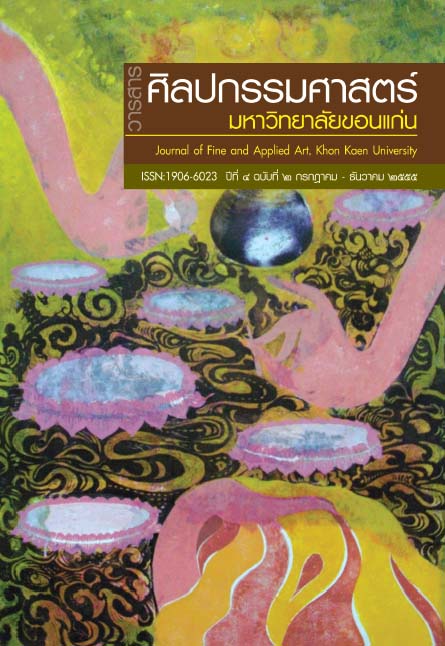การวิเคราะห์เพลงปี่โนราของนายควน ทวนยก
Main Article Content
Abstract
การวิเคราะห์เพลงปี่โนราของ นายควน ทวนยก มีความมุ่งหมายเพื่อศึกษา ชีวประวัติและทำนองเพลงปี่โนรา เฉพาะเพลงโหมโรง โดยการเก็บข้อมูลจากเอกสาร และด้านภาคสนาม ด้วยการสัมภาษณ์ บันทึกเทป มีผลการศึกษาพบว่า นายควน ทวนยก เกิดเมื่อวันที่ 18 ตุลาคม 2482 ณ บ้านหนองหอยออก ตำบลวัดควนขนุน อำเภอสิงหนคร จังหวัดสงขลา สมรสกับนางเจี่ยม ทวนยก มีบุตรด้วยกัน 3 คน มีเชื้อสายศิลปินจากบรรพบุรุษ เนื่องจากตระกูลของนายควน ทวนยก เป็นนักดนตรี ทั้งดนตรีไทยและดนตรีพื้นบ้าน ด้วยเหตุนี้ นายควน ทวนยก จึงได้เรียนรู้ดนตรี จนมีความเชี่ยวชาญทั้งจากบรรพบุรุษ ครูพักลักจำ และจากตัวนายควน ทวนยกเอง แต่ผู้ที่จัดเป็นบุคคลสำคัญในการฝึกปี่โนราให้เข้ากับท่ารำโนราแก่ นายควน ทวนยก คือ ขุนอุปถัมภ์นรากร การมีชื่อเสียงมากที่สุด เมื่อเป่าปี่โนราให้กับคณะโนรา วิทยาลัยครูสงขลา (เดิม) หรือปัจจุบันได้เปลี่ยนชื่อมาเป็นมหาวิทยาลัยราชภัฏ สงขลา ประกอบกับผู้รำโนราขณะนั้นคือ ผู้ช่วยศาสตราจารย์สาโรช นาคะวิโรจน์ และอาจารย์ธรรมนิตย์ นิคมรัตน์ ผู้ซึ่งมีฝีมือการร่ายรำที่สวยงาม ยังมีผลงาน ทั้งด้านวิชาการและการแสดงมากมาย ทั้งในประเทศและต่างประเทศ จนในปี พ.ศ. 2553 ได้รับการยกย่องให้เป็นศิลปินแห่งชาติ สาขาศิลปะการแสดง (ดนตรีพื้นบ้าน) และจากการวิเคราะห์เพลงปี่โนราของนายควน ทวนยก เฉพาะเพลงโหมโรงมีการ บรรเลงเรียงตามลำดับดังนี้ คือ 1) เพลงขึ้นปี่ เป็นเพลงแรกที่เป่าเพื่อทดสอบคุณภาพ เสียงปี่หรือเกริ่นนำ และเป็นเพลงที่มีสำเนียงเฉพาะของภาคใต้ 2) เพลงพัดชา มีทั้งหมด 4 ท่อน บรรเลงติดต่อกัน เพลงพัดชาถือเป็นเพลงครู 3) เพลงจิวยี่ 4) เพลง ชักใบ 5) เพลงธรณีกรรแสง (ชะนีร้องไห้) โดยทั้ง 4 เพลง ถือเป็นเพลงที่มีลักษณะ เป็นสำเนียงเพลงของภาคกลาง เพลงทั้ง 5 นี้ มีช่วงทำนองเสียงที่แตกต่างกันไป และมีการดำเนินทำนอง การลดทอนเสียง การเพิ่มเติมเสียง แต่ละเพลงมีการด้นสด เพลงบางเพลงขึ้นด้วยประโยคเพลงหรือเนื้อเพลง แต่บางเพลงขึ้นด้วยเพลงขึ้นปี่ แล้วตามด้วยเนื้อเพลง
Analysis of Pii-Nora Music of Mr. Khuan Thuanyok
The objectives of this research are to study the biography of Mr. Khuan Thuanyok and the melody of his Pii-Nora Music with concentration on the prelude music. The data were collected from documentary sources and field study through interviews and tape recordings. The findings of the study reveal three aspects of Pii-Nora Music played by Mr. Khuan Thuanyok. As for his biography, Mr. Khuan Thuanyok was born on 18 October 1939 at Ban Nonghoy Ok, Tambon Wat Khuankhanoon, Amphoe Singha Nakhon, Changwat Songkhla. He is married to Mrs. Jiam thuanyok. They have 3 children. He is a descendant of artist ancestors. Mr. Khuan Thuanyok’s family lineage and that of his wife were Thai classical and folk musicians. He inherited the music skills from his ancestors, Khru Phak Lak Cham (To learn something through the back door) and from his own self-taught technique. The person who was instrumental in providing training in pipe music for Nora dancing styles was Khoon Uppathamnarakorn. He was well-known for his music when he played it for the Nora troupe of Songkhla Teachers College, presently Rajabhat Songkhla University. The dancers for the Nora troupe were Ajarn Sarote Nakhvirote and Ajarn Thammanit Nikhonrat, who danced gracefully. He has contributed his works for his performance and academic records. He has performed both in Thailand and abroad. In 2010, he was awarded the cultural artists(Thai music) of Songkhla. An analysis of his pipe music reveals that his prelude music consists of the following: 1) Khuen Pi music is performed to test the sound quality of the pipe or as a prelude and the music is particularly related to the Southern Thailand’s tune. 2) 4 sections of Padcha music are played continuously. Pacha is considered the essence of the music. 3) Jiwyi music. 4) Chakbai music. 5) Thoraneekansaeng (Chanee Ronghai) music. The last 4 pieces of music are considered to be the musical tunes of the Central Thailand. All 5 pieces of music have different tempos and musical sounds are increased or decreased. Each piece of music has an extemporaneous rhyme. Some music starts with a musical phrase or lyric. Some music begins with pipe playing and is followed by lyrics.Article Details
Content and information in articles published in the Journal of Fine and Applied Arts of Khon Kaen University is regarded as the opinion and sole responsibility of the author(s) directly; therefore, editors are not obliged to agree to or share any responsibility with regard to the content and information that appears within these articles.
All articles, information, content, image, etc. that have been published in the Journal of Fine and Applied Arts of Khon Kaen University is the copyright of the Journal of Fine and Appllied Arts of Khon Kaen University. Any person or organization who wishes to distribute all or parts of the articles for further dissemination or other usage must first receive permission from the Journal of Fine and Applied Arts of Khon Kaen University before proceeding to do so.


